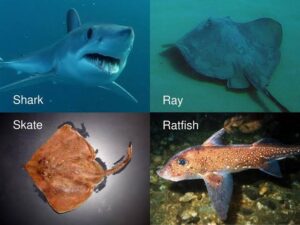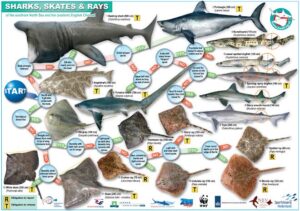Back to: ZOOLOGY 300 Level
WELCOME TO CLASS!
It’s always a joy to have you here, curious and ready to learn. Today, we’re about to meet some of the most iconic and fascinating animals in the water—the mighty sharks, graceful skates, and mysterious rays.
You may have seen sharks in movies like Jaws, or spotted a ray gliding through water in a nature documentary. But there’s much more to these creatures than their fearsome reputations. In fact, they are part of a unique group of fish called cartilaginous fishes. That means their skeletons are not made of hard bones like yours or mine, but of cartilage—the same flexible material in your ears and nose.
Sharks, Skates, Rays
Let’s break them down and understand what makes them so unique.

Cartilaginous Fish (Class Chondrichthyes)
Sharks, skates, and rays all belong to this class. The major features they share include:
- Skeleton made of cartilage
- Jaws and paired fins
- 5 to 7 gill slits on each side of the body
- Placoid scales, which are rough like sandpaper
- No swim bladder, unlike bony fish
Let’s look at each one in detail.
Sharks
Sharks are powerful, torpedo-shaped animals built for speed and hunting. They range from small species like the dwarf lantern shark to giants like the whale shark, which is actually a filter feeder.
- Body structure: Streamlined for fast swimming, with strong tail fins.
- Teeth: Continuously replaced throughout life. Some sharks lose thousands of teeth in a lifetime.
- Senses: Sharks have excellent smell, sight, and the ability to detect electrical signals using special organs called ampullae of Lorenzini—like natural electricity detectors.
- Reproduction: Can be oviparous (laying eggs), viviparous (giving birth to live young), or ovoviviparous (eggs hatch inside the body).
- Diet: Most are carnivorous, preying on fish, seals, and even other sharks.
In Nigeria’s coastal regions, sharks are occasionally caught by fishermen, especially in states like Bayelsa and Rivers. However, many are endangered due to overfishing.

Skates
Skates are similar to rays but have some key differences.
- Body shape: Flattened and disc-like, with large pectoral fins that make them look like they’re flying underwater.
- Tail: Thick and fleshy, often with small spines but no venom.
- Movement: They “glide” along the ocean floor using their large fins.
- Eggs: Skates are oviparous, laying egg cases known as “mermaid’s purses.”
- Habitat: Mostly bottom dwellers in deep or shallow marine waters.
Their calm nature and bottom-dwelling habits mean you’re less likely to notice them—but they play important roles in ocean ecosystems.
Rays
Rays are close relatives of skates but with more specialised features.

- Body: Also flat and wide, with wing-like pectoral fins.
- Tail: Long and slender, often with venomous spines, like in stingrays.
- Respiration: Have spiracles (openings) behind their eyes to help them breathe while buried in sand.
- Diet: Feed on molluscs and crustaceans by crushing them with their strong jaws.
- Reproduction: Most are viviparous, giving birth to live young.
Some types of rays, like manta rays, can reach massive sizes and glide through the ocean like underwater aircrafts. They are harmless to humans and are often seen as graceful and mysterious.
Summary
- Sharks, skates, and rays are cartilaginous fish with skeletons made of cartilage.
- Sharks are strong swimmers and expert hunters, with advanced sensory systems.
- Skates are bottom dwellers, laying eggs in “mermaid’s purses.”
- Rays are flat-bodied fish with venomous tails and wing-like fins, often giving birth to live young.
- Despite their differences, all three play vital roles in marine ecosystems.
Evaluation
- What is the main difference between cartilaginous fish and bony fish?
- Mention two features that make sharks good hunters.
- How can you tell a skate apart from a ray?
- What kind of skeleton do sharks, skates, and rays have?
- What is a “mermaid’s purse” and which animal lays it?
You’ve just gained a deeper understanding of some of the ocean’s most fascinating creatures. Whether gliding across the ocean floor or patrolling deep waters, sharks, skates, and rays remind us how diverse and wonderful life under the sea truly is. Keep that fire for learning alive—more exciting lessons await you!
